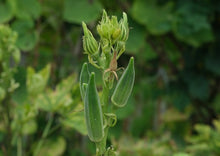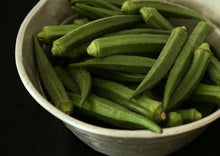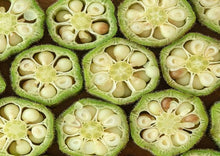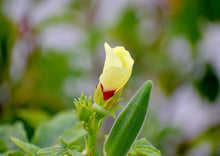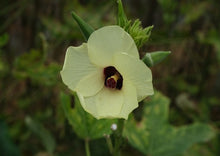
The Heirloom Organically Grown Clemson Spineless Okra is a unique and highly prized vegetable that has been grown for generations by farmers and gardeners. This variety of okra is known for its lack of prickly spines on the pods, making it easy to harvest and prepare for cooking. The Heirloom Organically Grown Clemson Spineless Okra is prized for its tender pods and its ability to produce an abundant harvest.
The Clemson spineless okra variety is originally from Clemson University, South Carolina, where it was developed by plant breeders in the early 1900s. It is known for its high yield and spineless pods, which makes it easier to harvest and prepare for cooking. This variety is also known for its high resistance to certain diseases, such as verticillium wilt, making it a great option for growers.
One of the unique characteristics of the Heirloom Organically Grown Clemson Spineless Okra is its heirloom status and organic growing methods. Heirloom varieties are passed down through generations and are known for their superior taste, texture and health benefits. This okra is grown using organic farming methods, which means it is free from harmful pesticides and chemicals, providing a safer and healthier option for consumers.
Heirloom Organically Grown Clemson Spineless Okra can be used in a variety of dishes, it can be fried, steamed, grilled, sautéed, or used in soups and stews. It is also a great source of nutrients, such as vitamin C, potassium, and dietary fiber. It is also a good source of antioxidants and anti-inflammatory compounds.
This heirloom variety of okra is also known for its ability to grow in a variety of conditions, making it a great crop for small farmers and home gardeners. It can be planted in both warm and cool climates, and can be grown in a variety of soil types. It is also drought-tolerant, making it a great option for dry regions.
"Clemson Spineless" okra produces dark green edible pods suitable for use in culinary dishes around the world. This Heirloom produces high yields of spineless, tender ribbed pods and for better cooking purpose pick pods when they about 3inches long and tender. However, pods do get much bigger when left on the plant for collecting seeds. The pods turn into dry brown woody which is an indication for seed maturity. This plant variety keeps growing until the first frost, typically in North America the plants grow an average height of 8 feet or taller in areas with a long, warm growing season. Unlike other okra varieties, the leaves and stems of the "Clemson Spineless" plant are spine-less, which makes it easily accessible without any irritation while picking the pods.
Common Okra Growing Problems
- Seeds did not germinate:Soil is not warm enough for germination; soil temp must be at least 70°F for okra to germinate. Pre-soak seeds in water for 24 hours before sowing.
- Plant flowers but pods do not form:Temperature fluctuations can interfere with pollinations. Pollination will be poor if temperatures rise above 90 °F or drop below 55 °F. Too little light, water stress, and excess nitrogen also inhibit pod formation.
- Spots on leaves; spot become circular with gray centers.Leaf spot is a fungus disease. Plant resistant varieties. Rotate crops. Keep garden free of plant debris. Plant in well-drained soil.
- Black water-soaked blotches on stems and leaves:Anthracnose is a fungus disease that spreads in high humidity & rainfall. Leaves may wither and fall. Plant may die back. Remove & discard infected plants. Avoid working in garden when it is wet which can result in spread of spores.
- Plants stunted, leaves yellow, roots decayed:Fusarium root or stem rot is a fungal disease that favors warm soil. Remove infected plants and plant debris that harbor fungus. Rotate crops. Rotate crops regularly. Solarize the soil in late spring or summer.
- Leaves turn yellow and then brown from the bottom up; plant loses vigor:Root knot nematode is a microscopic eelworm that attacks roots. Rotate crops. Remove old plant debris from garden.
- Yellow leaves and curled, shiny specks on leaves: Aphids are tiny, oval, and yellowish to greenish pear-shaped insects that colonize on the undersides of leaves. They leave behind sticky excrement called honeydew which can turn into a black sooty mold. Use insecticidal soap.
- Yellow leaves; tiny white winged insects around plants.Whiteflies will congregate on the undersides of leaves and fly up when disturbed. Remove infested leaves & the whole plant if infestation is serious.
- Holes in pods.Corn earworm is a brown-headed caterpillar with lengthwise stripes to 2 inches long; the adult is a night-flying moth with brownish or olive wings and bright green eyes. The worm will tunnel into pods. Handpick caterpillars and destroy.
- Deformed pods.Southern green stink bug is a light green bug to ½-inch long. Bug sucks sap from leaves and pods causing them to become twisted and deformed. Spray with insecticidal soap.

Heirloom Organically Grown Clemson Spineless Okra, Tender pods, abundant harvest, spineless pods, easy to harvest, prepare, Clemson University, South Carolina, high yield, disease resistance, verticillium wilt, Heirloom, organic farming, free from pesticides, chemicals, healthier option, fried, steamed, grilled, sautéed, soups, stews, vitamin C, potassium, dietary fiber, antioxidants, anti-inflammatory compounds, adaptable, small farmers, home gardeners, warm, cool climates, soil types, drought-tolerant, sustainable, traditional, organic vegetable.





